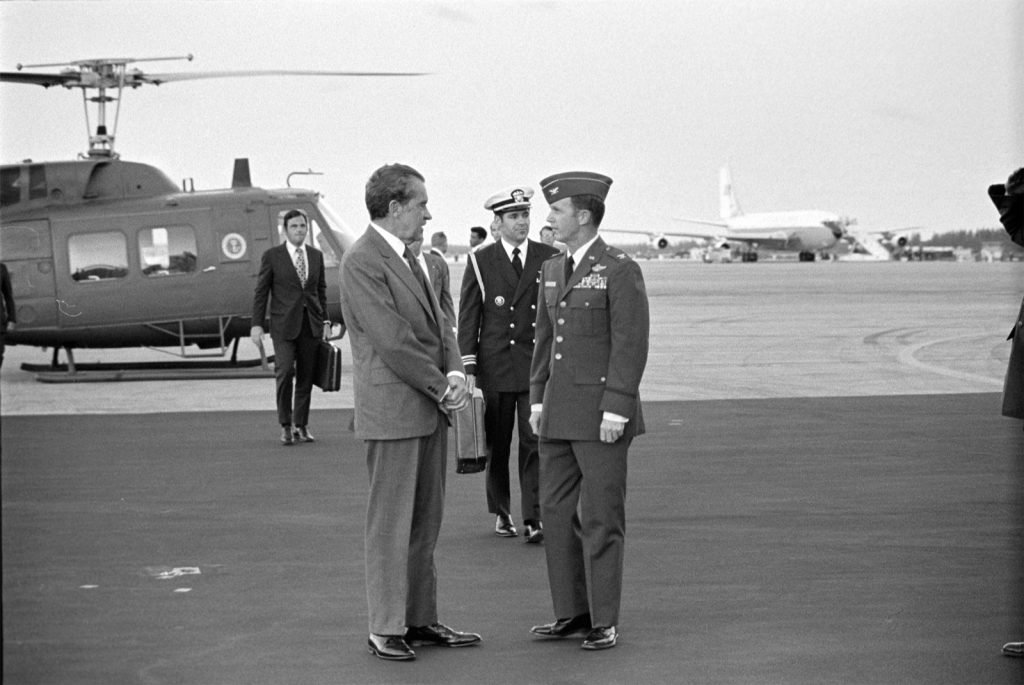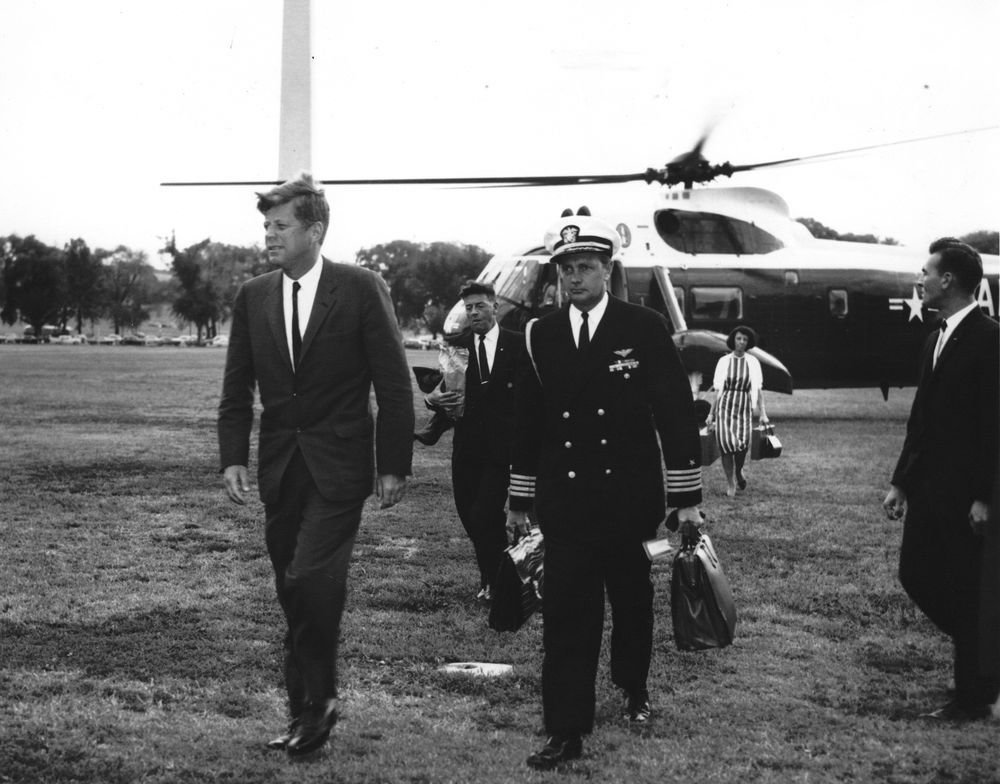How Will the ‘Nuclear Football’ Handoff Go Down if Trump Skips Biden’s Inauguration?

Colloquially known as so-called nuclear football, the the Presidential Emergency Satchel contains the documents, codes, and communications equipment needed to authorize a nuclear strike in minutes. Photo via @Johnwritlarge on Twitter.
President Donald Trump said he will skip President-elect Joe Biden’s inauguration in Washington on Jan. 20. That decision complicates one of the world’s most important transfers of military power — the assumption of command and control authority over America’s nuclear arsenal.
Every US president since the dawn of the Cold War has, in theory, been ready 24/7 to order a nuclear attack within a 15-minute window. However, even if Trump and Biden are at different locations on Jan. 20 — perhaps separated by hundreds of miles — the Department of Defense has plans in place to ensure the seamless transition of presidential nuclear command and control authority. Consequently, many defense experts agree that there will not be a lapse in America’s strategic readiness.
“There won’t be any ambiguity on inauguration day,” said Garrett Graff, author of the 2017 book, Raven Rock: The Story of the U.S. Government’s Secret Plan to Save Itself — While the Rest of Us Die.
“Joe Biden becomes the valid and sole official in charge of the nation’s military and nuclear arsenal at noon on the 20th, just as the Constitution intends,” Graff told Coffee or Die Magazine in an email.

If an adversary launches nuclear-armed missiles against the United States, the president may have only about 15 minutes to order a retaliatory strike — an action that does not require Congressional approval.
America’s nuclear command and control structure could be catastrophically wiped out by the first wave of a so-called “bolt out of the blue” surprise attack. Thus, in order to guarantee an American nuclear counterstrike gets off the ground within 15 minutes, every president since John F. Kennedy has been accompanied at all times by a military aide carrying a briefcase called the Presidential Emergency Satchel.
Colloquially known as the “nuclear football,” the roughly 45-pound briefcase contains the documents, codes, and communications equipment needed to authorize a nuclear strike within minutes. The “football” represents the greatest military power ever possessed by a single human. It also symbolizes the defining power of America’s executive branch.
“In a country with no bejeweled crowns or royal thrones, the black Football briefcase is perhaps the only physical manifestation of our nation’s sovereign, the outward sign of presidential power,” Graff writes in Raven Rock.
Called the National Command Authorities, America’s nuclear command and control structure governs the so-called Nuclear Triad, comprising an arsenal of nuclear-armed intercontinental ballistic missiles (ICBMs), strategic bombers, and submarine-launched missiles.
Once launched, America’s nuclear-armed ICBMs cannot be recalled.
At least five active-duty military aides, one from each military service, are responsible for carrying the Presidential Emergency Satchel. Rather than a device to actually launch missiles, the “football” is effectively a series of binders with a flip-chart notebook of preselected war plans the attendant military aide would use to explain the president’s retaliatory options.
The briefcase also contains secure communications equipment to contact the Pentagon’s National Military Command Center. The Pentagon maintains duplicate footballs at the side of the vice president and the secretary of defense every day.
The president is also supposed to always carry a card known as the “Biscuit” that contains the authentication codes needed to authorize the use of nuclear weapons. The codes themselves are sealed plastic cards, created by the National Security Agency, that authenticate the president’s identity to military commanders.
Under normal circumstances, outgoing presidents are on hand to witness their successors assume office. And, to ensure continuity, the physical transfer of the presidential football usually occurs between military aides in the background. According to multiple military experts, on Jan. 20 there will likely be military aides with Presidential Emergency Satchels alongside both Trump and Biden.
Also, the Department of Defense will likely have prepared a “Biscuit” for Biden with his own unique authentication codes that become effective at noon on inauguration day. After Biden assumes office, Trump’s authority to order a nuclear strike will instantly cease.
“It’s not that the codes ‘expire’ so much as President Trump’s authority will expire at 11:59 a.m. on January 20th,” Graff told Coffee or Die Magazine. “After that, it doesn’t matter if he tries to call into the Pentagon and read off the correct code — he won’t be seen as a valid voice for the National Command Authority.”

While the presidential transition from Trump to Biden presents a unique transfer of authority challenge — it’s not necessarily an unprecedented situation.
When President Richard Nixon left the White House for the final time as commander in chief on Aug. 6, 1974, he departed Washington aboard a Boeing 707 aircraft designated Air Force One. At 3 minutes and 25 seconds past noon — the instant President Gerald Ford finished reciting his oath of office — the Air Force pilot radioed air traffic control and changed the aircraft’s call sign from Air Force One to SAM 27000. (SAM is an Air Force acronym for “Special Air Mission,” a common designation given to VIP transport flights.)
On board the aircraft, however, Nixon had already relinquished his authority over America’s nuclear arsenal. There was no “nuclear football” aboard the 707 that morning with the outgoing president. In the interval between Nixon’s departure from Washington and Ford’s assumption of office, nuclear command and control authority briefly rested with Defense Secretary James Schlesinger and Secretary of State Henry Kissinger.
“Schlesinger feared that the president, who seemed depressed and was drinking heavily, might order Armageddon. And on that August morning, the military and White House aides had left the nuclear codes with the incoming president,” Graff writes in Raven Rock.

Lyndon Johnson, then vice president, was in Dallas on Nov. 22, 1963, the day of Kennedy’s assassination. After taking the oath of office as president, Johnson flew back to Washington on board the same Air Force 707 jetliner that had taken Kennedy to Dallas that morning.
While there was significant confusion regarding the transfer of Secret Service protocols, Johnson’s co-location with Kennedy that day probably helped the transfer of presidential nuclear authority. Had Johnson been unreachable in the minutes immediately following Kennedy’s death, there would have been a power vacuum until he was located and sworn in as commander in chief. Nevertheless, Air Force Strategic Air Command — the Cold War command in charge of America’s nuclear-armed strategic bombers and ICBMs — went on alert the day of Kennedy’s assassination.
After the Cold War ended in 1991 with the collapse of the Soviet Union, it was widely thought that the threat of an apocalyptic nuclear exchange had passed. However, Russia and China are both expanding their arsenals of nuclear and conventional strategic weapons, thereby presenting novel threats to the US homeland and unsettling the post-Cold War status quo.
According to the Arms Control Association, the United States today possesses some 6,185 nuclear weapons, while Russia maintains 6,490 such weapons in its arsenal. The US-based Federation of American Scientists estimated China now has about 320 nuclear weapons.

BRCC and Bad Moon Print Press team up for an exclusive, limited-edition T-shirt design!
BRCC partners with Team Room Design for an exclusive T-shirt release!
Thirty Seconds Out has partnered with BRCC for an exclusive shirt design invoking the God of Winter.
Lucas O'Hara of Grizzly Forge has teamed up with BRCC for a badass, exclusive Shirt Club T-shirt design featuring his most popular knife and tiomahawk.
Coffee or Die sits down with one of the graphic designers behind Black Rifle Coffee's signature look and vibe.
Biden will award the Medal of Honor to a Vietnam War Army helicopter pilot who risked his life to save a reconnaissance team from almost certain death.
Ever wonder how much Jack Mandaville would f*ck sh*t up if he went back in time? The American Revolution didn't even see him coming.
A nearly 200-year-old West Point time capsule that at first appeared to yield little more than dust contains hidden treasure, the US Military Academy said.












